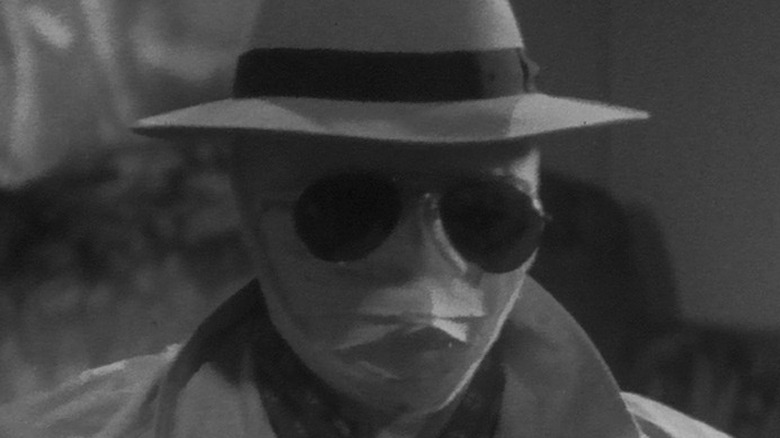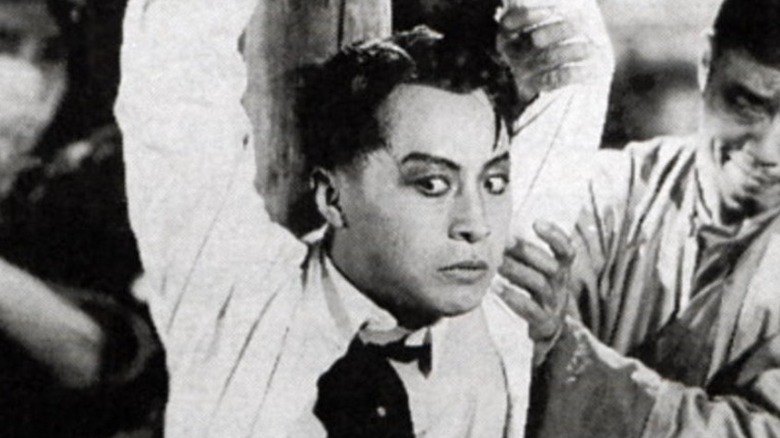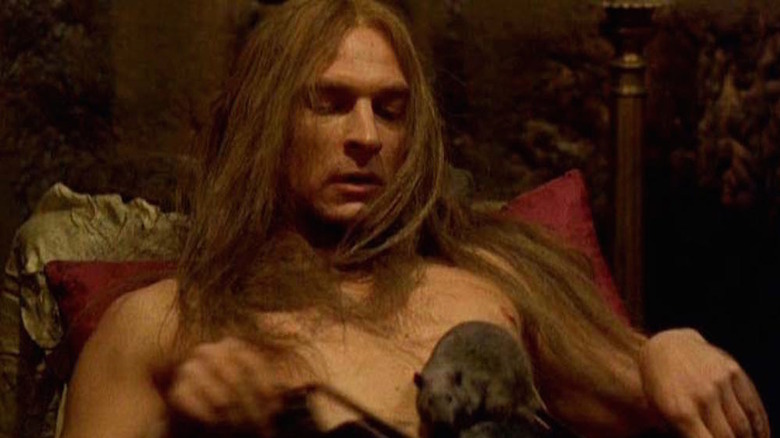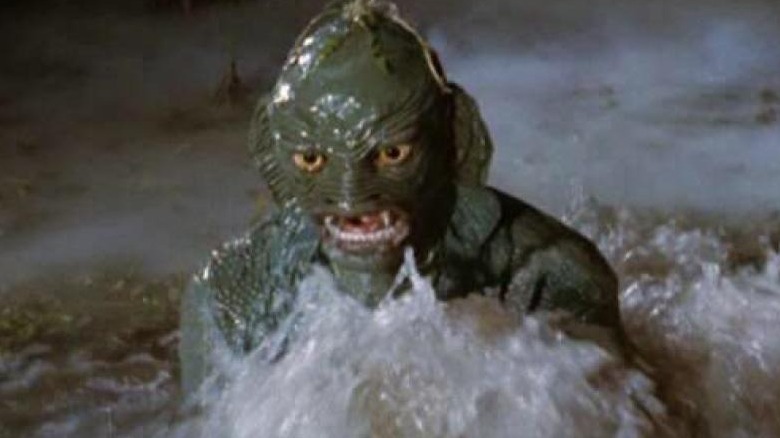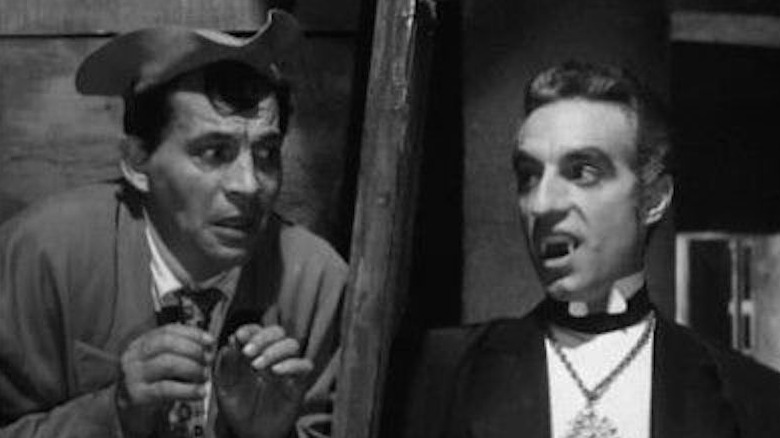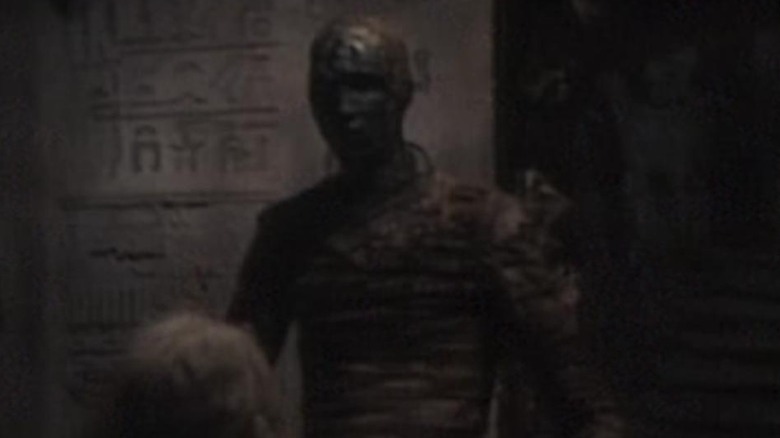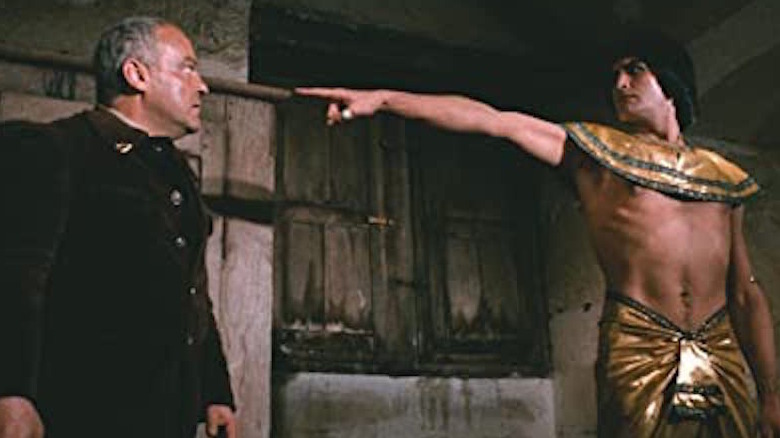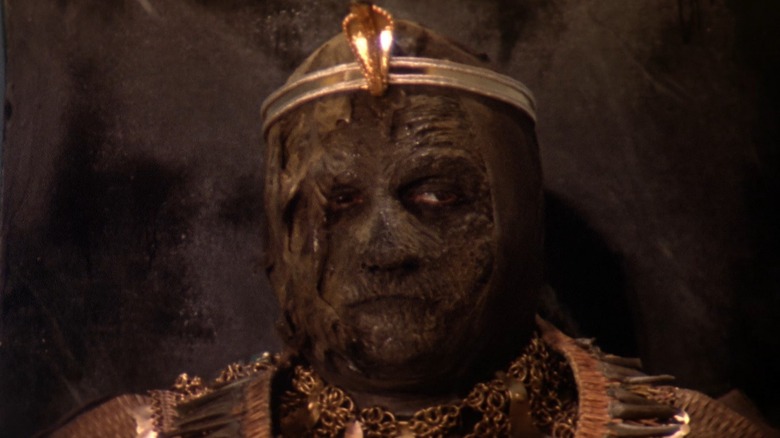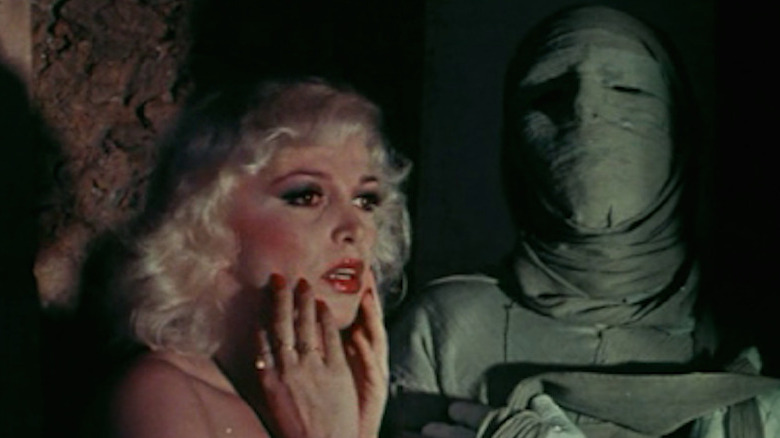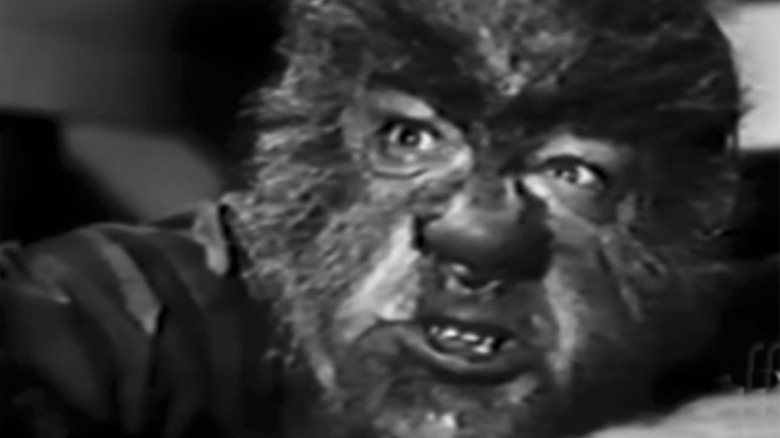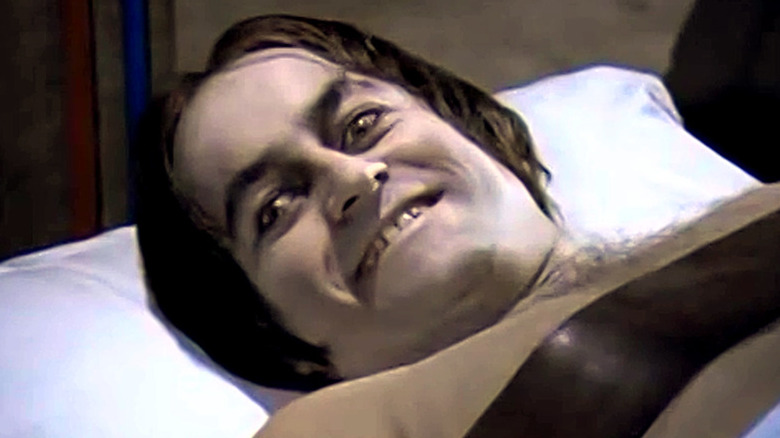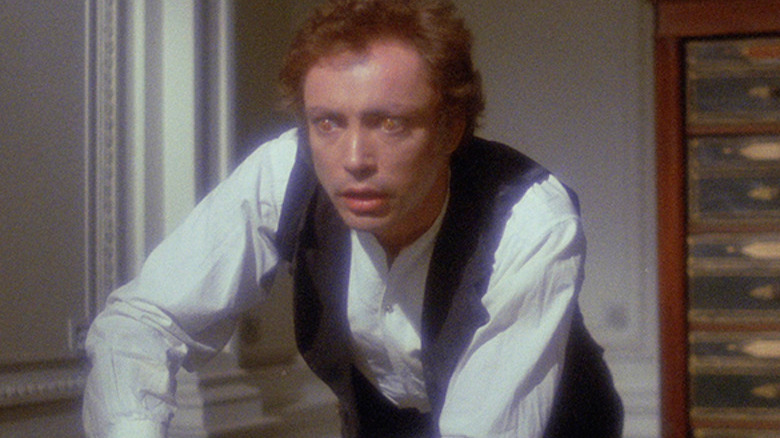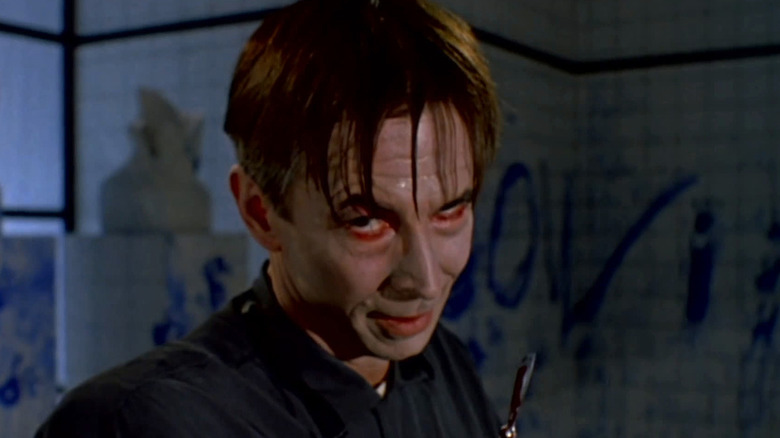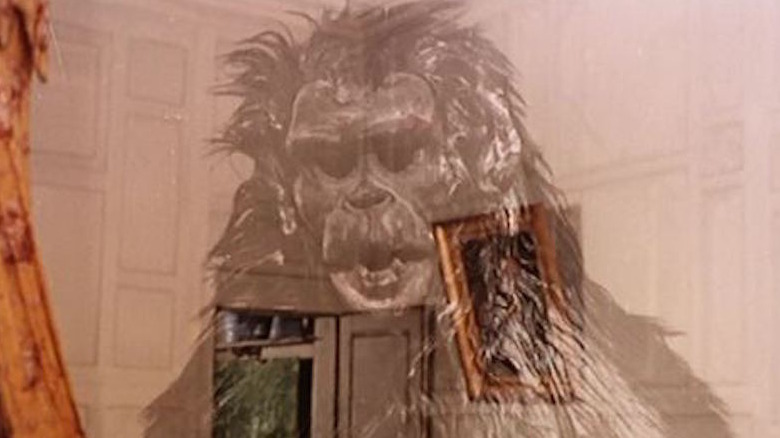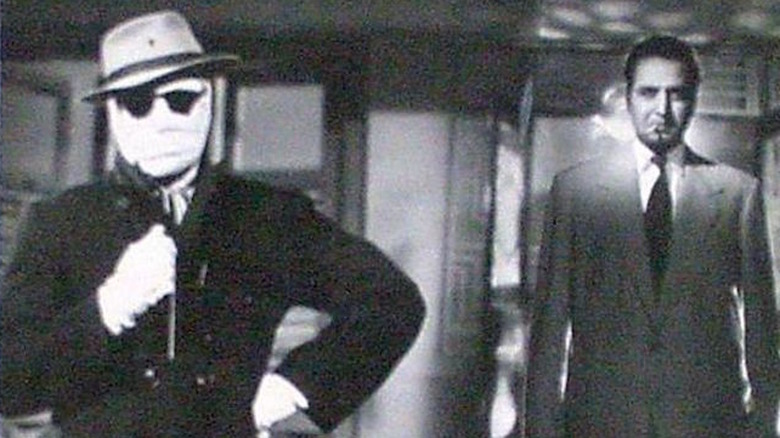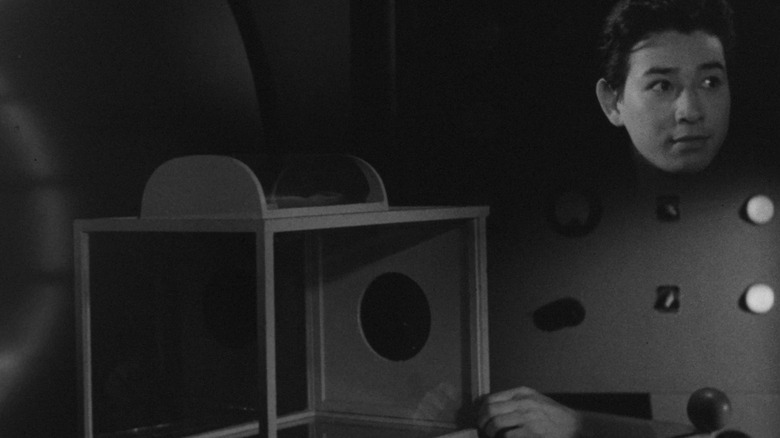Bizarre International Versions Of Classic Movie Monsters
We may receive a commission on purchases made from links.
Of the hundreds, if not thousands of monsters that have rampaged across movie screens since the film industry began in the late 19th century, only a handful have remained popular for the majority of that time. Godzilla and King Kong may have a half-century (or more) of popularity under their respective belts, Jason and Michael Myers might have multiple decades, but the septet collectively known as the Universal Classic Monsters — Dracula, the Frankenstein Monster, the Mummy, the Wolf Man, the Invisible Man, the Phantom of the Opera, and the Creature from the Black Lagoon — along with Robert Louis Stevenson's Dr. Jekyll and Mr. Hyde remain the GOAT when it comes to long-running horror fandom, inspiring countless features about their exploits. Their appeal is so broad that it transcends the horror genre, minting them as genuine pop culture icons, preserved in forms ranging from collectible figures to postage stamps and breakfast cereals.
The stardom of these classic monsters even breaks international barriers, resulting in countless adaptations, spoofs, unofficial sequels, and outright theft of their likeness. Some of these foreign fiends have become classics unto themselves: England's Hammer Films released a string of horror titles featuring nearly all the classic characters, and horror fans consider many on par with the originals. There's also a host of truly unique and weird takes on these monsters from Europe, Asia, and South America. Below, a by-no-means complete (and spoiler-heavy) list of the most bizarre international rip-offs of classic monsters.
China's Phantom appears in Song at Midnight
The 1937 Chinese feature "Song at Midnight" adapts the plot of "The Phantom of the Opera" for a chilling, frequently moving drama-thriller that successfully folds the Gothic visual palette of Universal's horror cycle into a story fueled by Chinese politics and culture. The film's Erik is Song (played by Jin Shan), a former opera singer and revolutionary who was tortured by his lover's father — a wealthy landowner — and disfigured by a jealous rival. Ashamed of his appearance, he becomes a ghostly figure at an abandoned theater until re-emerging to assist a troupe of actors, which brings the crimes committed against him into the light.
Director Ma-Xu Weibang displays remarkable deftness with the emotional elements of the film, as well as an understanding of horror film imagery that rivals the Western product of the period. The unveiling of Song's face after his disfigurement, and the terror that it causes his family, skillfully blends both horror and pathos: Song's face is horrifying to behold, and the reaction to his fate is heartbreaking. It's worth noting that the cause of Song's disfigurement — acid thrown in his face — was later adopted by Western adaptations of "Phantom" (both the book and 1925 version cite his appearance as a birth defect).
Remarkably popular at the time of its release, "Song" has been remade several times since, including a two-part version by Shaw Brothers Studios in 1962, and 1995's "The Phantom Lover," directed by Ronny Yu ("Bride of Chucky"). There are also several television series based on the film; Ma-Xu released an official sequel in 1941.
Dario Argento's Phantom was a handsome jerk
Director Dario Argento earned good notices for his 2022 thriller "Dark Glasses," but the Italian horror maestro spent much of the 1990s and 2000s in a career funk, releasing disappointing films like "The Card Player," "Dracula 3D," and his 1998 take on "The Phantom of the Opera." Like many of Argento's films, his "Phantom" looks and sounds sumptuous, thanks to expensive sets and a score by Ennio Morricone. His take on the Phantom is initially unique: Julian Sands, who plays the role, wears no mask to cover a terrible physical handicap, and looks more like a male model on a romance paperback than traditional movie Phantoms or a man quite literally raised by rats in the Paris sewers.
The novel aspect of Argento's "Phantom" ends there. The director's signature gory setpieces seem forced, as if he felt obligated to shoehorn them into the film to assure fans he was not making a Gothic romance like the Broadway production. The script by Argento and Gerard Brach (who penned many of Roman Polanski's films) wants viewers to see the Phantom as tragic, but depicts him a vicious and petty brute, visiting terrible punishments on those who defy him, including singer Christina (Argento's daughter Asia Argento), whom he allegedly loves. They also give their Phantom the apparent ability to communicate telepathically with his adoptive rat family, which may have been a bridge too far for even Argento devotees.
The Boy Scouts meet the monsters in Mexico
Say what you will about the Boy Scouts, but as the 1973 Mexican horror-comedy "Chabelo y Pepito contra los monstruos" ("Chabelo and Pepito vs. the monsters") clearly displays, in addition to the knot-tying and camping requirements, scouting prepares you for dealing with vampires and werewolves.
Case in point: Scouts and cousins Chabelo and Pepito, who are played respectively by juvenile actor Javier Lopez and Martin Ramos (inexplicably a middle-aged man who acts like a pre-teen boy). While on a camping trip, the pair split from their troop to find a missing gorilla (!) in hopes of claiming reward money. They track the ape to a hidden cavern, where they encounter a mummy, the Frankenstein Monster, and a very angry and loud Gill-Man. A paunchy Dracula and Wolf Man are later located in a haunted house, which also happens to be the secret lair of uranium smugglers working for a disembodied brain.
Some of the monsters in "Chabelo and Pepito" appear to be wearing ill-fitting Halloween masks by American costume maker Don Post, but the Gill-Man's immobile mask appears to be the work of the film's makeup effects crew. It's also the worst of the lot; the edges of the mask flap throughout the monster's entire appearance while the actor inside the suit thrashes about with abandon. The Gill-Man also screams ceaselessly during its fight with the gorilla, which ends with a bite to the ape's neck that leaves the Gill-Man's mouth dripping with blood — a surprising denouement to a film intended for very small kids.
More monsters down Mexico way in Castle of the Monsters
Chabelo and Pepito weren't the only Mexican screen comics to face a monster rally in one of their movies. Antonio Espino, who performed as "El Clavillazo," stumbled upon a horde of Hollywood creatures in 1958's "El Castillo de los Monstruos" ("The Castle of the Monsters"), which preceded Chabelo and Pepito's adventure by 15 years. The premise travels along a similar pathway — silly heroes uncover sinister forces creating monsters for their diabolical plan — but here, it's El Clavillazo, whose character might be an undertaker, venturing into the castle of Dr. Sputnik to rescue his true love, Beatriz, and encountering the doctor's creations, which include a vampire, the Frankenstein Monster, a Wolf Man, Mummy, Gill-Man, and a sort of apeman/missing link.
Several sources refer to "Castle" as a remake of "Abbott and Costello Meet Frankenstein," but the similarities are primarily in the monsters. The movie is fueled by its own oddball aesthetic, which mixes broad physical humor and well-worn gags with moments of pure absurdity (when the Frankenstein Monster is defeated, it collapses into a pile of nuts and bolts; the Gill-Man transforms into a dead fish). Escaping with his dignity largely intact is actor German Robles (as the film's vampire), who earned critical praise on both sides of the border for a string of turns as the undead Count Lavud and other monsters in several excellent Mexican horror films like "El Vampiro" ("The Vampire", 1957).
Egyptian mummies play zombie in Dawn of the Mummy
When is a mummy movie not really a mummy movie? When it's a horror movie featuring mummies that act, and more importantly, eat like zombies.
Such is the case with "Dawn of the Mummy," a curious bit of cross-cultural moviemaking from 1981 featuring American leads and an Italian crew overseen by an Egyptian producer-director. The mummy of the title is actually an ancient pharaoh and his attendants, who are revived by the lights of a fashion shoot and messily devour the models, photographers, a crew of grave robbers, and the unlucky inhabitants of a nearby village, including attendees at a wedding.
Depicting the mummies in "Dawn" as flesh-eating zombies adds a novel wrinkle to "Dawn"; prior to this, the worst fate that might befall you at the hands of a movie mummy was strangulation. The rotting cadavers here, constructed by makeup effects by Maurizio Trani ("Zombi 2") are decidedly more menacing because of their appetites, and the abundant gore they create more than makes up for the sluggish pacing and uproariously bad performances and dialogue. Producer-director Frank Agrama went on to co-found the film and TV distribution company Harmony Gold, which distributed the "Robotech" anime for American TV. He later made headlines for his involvement and acquittal in trials involving tax evasion, fraud, and embezzlement that also ensnared his longtime associate, media mogul and Italian Prime Minister Silvio Berlusconi.
Love Brides of the Blood Mummy: it's exactly what you think it is
If "Love Brides of the Blood Mummy" suggests a cheap and sleazy horror film, congratulate yourself on having such keen instincts. The Blood Mummy of this 1973 French/Spanish co-production is a revived Egyptian prince who spends precious little time wrapped in bandages before undertaking an unpleasant scheme from his temporary home, a remote village in 19th-century Spain. The prince hypnotizes the occultist (George Rigaud) that located his sarcophagus and sends him to kidnap various women in order to drink their blood (and depending on which version you're watching, conduct other rude business).
This goes on for a very long time, until the occultist comes to his senses and lops off the prince's arm, which remains alive via some primitive stop-motion animation. As with many European exploitation films, two versions of "Love Brides" were made: one in which the actresses kept their clothes on for the entire running time, and one in which they did not. The latter is now available on Blu-ray for the curious.
Paul Naschy gets wrapped up in The Mummy's Revenge
Spanish actor and filmmaker Paul Naschy was perhaps best known as the mournful Waldemar Daninsky, a nobleman cursed with lycanthropy, in a sizable number of violent horror features made in the 1960s and 1970s. Like horror star predecessors Boris Karloff and Christopher Lee, Naschy also tackled other monsters during his long career, including Dracula, Mr. Hyde, various Satanists and psychopaths, and in 1975, a rampaging mummy in "The Mummy's Revenge."
Naschy, who penned the script, gives himself the opportunity to play two villains in the film: he's swathed in bandages and jewels as the revived corpse of the cruel pharaoh Amenhotep, and looks pretty sharp in a Nehru jacket as the mummy's human assistant, Assad Bey, who brings his master back to life with the blood of female victims.
Naschy, who was a weightlifter before his acting career, cuts a burly figure as Amenhotep, who lacks the wraith-like frame and bearing of Karloff and Lee's mummies. But as with Naschy's Wolf Man and other monsters, his mummy is an engine of ferocious energy and destruction. Amenhotep doesn't frighten his victims to death or snuff out their lives with a clammy hand. He smashes open heads, squeezes heads until eyes pop out, and generally acts as a one-man wrecking crew from the Upper Nile. He may lack the menace and relentless drive or Karloff and Lee's monsters, but Naschy's mummy is a genuine terror.
The bizarre Brazilian Secret of the Mummy
In the 1982 Brazilian film "The Secret of the Mummy," a mad scientist named Professor Vitus (Wilson Grey) murders a group of archaeologists to obtain a map that reveals the burial place of an ancient Egyptian soldier executed and mummified for gruesome crimes. Though hailed for his discovery, Vitus actually wants the mummy to provide proof that his Elixir of Life resurrects the dead. Once revived, the mummy is sent to kidnap test subjects for the doctor's other experiments, which use Dr. Frankenstein's formula to turn humans into animals or homicidal lunatics. The kidnappings, transformations, and various murders and decapitations eventually bring around police and reporters, but not before the mummy falls in love with a woman he believes to be the reincarnation of his long-lost love (spoiler alert: she's not).
Welcome to the weird world of Brazilian filmmaker Ivan Cardoso, who has directed a string of low-budget horror-comedies that freely mix genre, film stock, and acceptable levels of taste for more than five decades. Cardoso's freeform aesthetic and unbridled love for classic horror films has resulted in collaborations with the equally offbeat Brazilian filmmaker Jose Mojica Marins (a.k.a. "Coffin Joe"), who appears briefly in "Mummy," and Paul Naschy, but his work went largely unseen in English-language territories until the late '90s and early 2000s. "Mummy" is a typical example of Cardoso's approach: a frantic but sincere mix of experimental and exploitation tropes with home movie-grade production quality and grade-school humor.
Face of the Screaming Werewolf is a Mexican-American Frankenfilm
After having made several terrible horror movies on his own, such as 1960's "Teenage Zombies," American filmmaker Jerry Warren struck upon the idea of buying horror movies from other countries and reworking them to create new titles that were more palatable for American audiences. Unfortunately, "Creature of the Walking Dead" (1965) and other stitch jobs were equally atrocious: Warren ignored even the most basic linear plot, a situation made worse by bad dubbing, edits and confusing new footage shot by Warren.
Perhaps the most bizarre of Warren's Frankenfilms was "Face of the Screaming Werewolf," a 1965 fusion of two Mexican features: the horror-comedy "La Casa del Terror," which featured actor Lon Chaney Jr. as a mummified werewolf who returned to life, and "The Aztec Mummy," about an ancient warrior revived by the theft of his treasure. Much of the comedy from "Casa" was trimmed away, though that film's star, Tin-Tan, still shows up at the end of "Werewolf," seemingly out of nowhere, to save the day. Warren also added new footage featuring American actors playing policemen and newscasters in an attempt to make some sense of the plot. It didn't help.
Chaney hadn't donned werewolf makeup on film since 1948's "Abbott and Costello Meet Frankenstein," so his appearance in the role lends a touch of nostalgic pleasure. Unfortunately, Chaney's health was in decline, due in part to alcoholism and other issues, and he looks worn out when not wearing the makeup. However, once the (cheap-looking) fur and fangs are added, he seems to find his old energy, and howls and growls with abandon.
If you or anyone you know needs help with addiction issues, help is available. Visit the Substance Abuse and Mental Health Services Administration website or contact SAMHSA's National Helpline at 1-800-662-HELP (4357).
Introducing Dr. Jekyll and Mr. Naschy
As with "The Mummy's Revenge," the 1971 Spanish horror feature "Dr. Jekyll vs. the Werewolf" gives star/scripter Paul Naschy the chance to wear multiple monster masks while also giving fans more of his best-known character, the lycanthrope Waldemar Daninsky. In his fifth outing as the doomed nobleman, Naschy heads to modern-day London to seek out the grandson (Eurocult vet Jack Taylor) of the original Dr. Jekyll. The good doctor reportedly has a cure for lycanthropy that involves, of all things, his grandfather's formula. According to Jekyll's theory, a transformation into Mr. Hyde will cancel out Daninsky's werewolf. And if that sounds like crackpot science to you, you're absolutely right.
Rather than eliminating Daninsky's werewolf side, the Hyde potion simply adds another monstrous personality that emerges at the absolute worst moments — like in the middle of a disco, where Daninsky, as Hyde, transforms into the werewolf and decimates the dancers under flickering strobe lights. Hyde is exponentially worse than the werewolf, who always regretted the murders he committed in monster form. As Hyde, Daninsky — whose shaggy hairpiece and wicked grin seem like a nod to John Barrymore's Hyde in the 1920 silent version — revels in sadistic murder. The only solution for this lose-lose scenario is Daninsky's death, but in typical fashion, he was back in 1973's "Curse of the Devil."
The arthouse grossout that is Dr. Jekyll and the Women
Having played both Dracula and Baron Frankenstein for director Paul Morrissey in the 1970s, German actor and cult favorite Udo Kier added another iconic horror character, Dr. Jekyll, to his credits with the 1981 French/West German film "Dr. Jekyll and the Women," which doesn't reinterpret the Robert Louis Stevenson novella as much as setting it ablaze while writer/director Walerian Borowczyk douses it with gasoline, working overtime to depict a catalog of cruelties.
Kier's kindly Jekyll is set to marry Fanny Osbourne, played by Borowczyk's frequent muse and companion, Marina Piero. Fanny, who shares a name with Louis Stevenson's real-life spouse, is unaware that her fiancé has created a solution (which he keeps in a bathtub) that transforms him into the hideous Mr. Hyde (Gerard Zalcberg). She quickly learns all about his alter ego when he arrives at a celebration for her wedding and proceeds to torture, assault, and kill the guests. Fanny responds to this orgy of death by taking a dip in Jekyll's tub and joining Mr. Hyde in, well, monster-mony.
Borowcyzk's attention to period detail and rejection of societal restraints are largely overshadowed by the film's catalog of cruelty, which kicks off with the vicious murder of a child and at various points encompasses decapitation, shooting people with arrows, and forced piano playing. In short, it's a grindhouse picture disguised as an arthouse title, probably best enjoyed by fans of the former.
As Mr. Hyde, Anthony Perkins was on the Edge of Sanity
Released between "Psycho" sequels in 1988, the British-Hungarian thriller "Edge of Sanity" gave star Anthony Perkins an opportunity to expand his repertoire of horror roles. Perkins played both a deeply repressed Dr. Henry Jekyll and his leering libidinous alter ego, here dubbed Jack Hyde, whose nighttime excursions through the underworld of 19th century London result in a series of murders the police pin on Jack the Ripper.
Perkins appears to take both roles quite seriously, even Hyde — whose gaunt features and sweat-slicked hair bear a strong resemblance to Lux Interior, the late, great vocalist for the Cramps — cavorting with ladies of the night in an absurd, Catholic Church-themed brothel. The movie itself is well appointed with lavish sets and Hungarian locations, but the script is pure nonsense. Jekyll turns into Hyde after smoking cocaine and ether — essentially, crack cocaine — mixed by a chimp in his lab, and the film pads far too much of its running time with endless softcore romps that play like glossy music videos. Director Gerard Kikone and producer/co-writer Harry Alan Towers were old hands at naughty European fare, having overseen dozens of adult-only titles in the 1960s and 1970s.
If you or anyone you know needs help with addiction issues, help is available. Visit the Substance Abuse and Mental Health Services Administration website or contact SAMHSA's National Helpline at 1-800-662-HELP (4357).
Invisible Dead, Invisible Man - or Invisible Ape
Though one of the many alternate titles for the 1970 French-Spanish exploitation film "The Invisible Dead" is "Orloff and the Invisible Man," it's important to know that the unseen being of the title isn't H.G. Wells' antagonist, the mad Griffin. Honestly, it also doesn't feature an actual invisible man. What you do get is an amorous, blood-drinking invisible monster, depicted as an actor in a ratty gorilla costume. It only "appears" in the last few minutes of the movie, which means that the rest of the picture is devoted to endless loops of nonsensical dialogue involving the monster's creation and a few moments of invisibility shenanigans, such as chairs pulled on wires to appear as if they're moving by unseen hands.
The invisible gorilla is the handiwork of Dr. Orloff, whom Eurocult horror fans know from director Jess Franco's "The Awful Dr. Orloff" and several subsequent unrelated sequels. Swiss actor Howard Vernon, who played Orloff in the Franco film, reprises the role here for director/co-writer Pierre Chevalier. Vernon's presence is the sole note of class in the entire picture, which struggles to meet even basic requirements for motion pictures, such as keeping scenes in focus or presenting a plot that is accompanied by logic.
Mr. X kicked off a wave of Indian invisible men
The 1957 Hindi fantasy-drama "Mr. X" appears to have helped to kick off a string of Indian films about invisible men that continues to the present day. "Mr. X," from 1957, starred one of the country's bona fide superstars, Ashok Kumar, as a man (also named Ashok Kumar) who uses an invisibility serum to clear his name of a murder charge. The special effects are primitive by modern standards, and the plot crams comedy, traditional Bollywood musical numbers, suspense, and science fiction into its running time. But "Mr. X" moves at a brisk pace, and the constantly shifting focus holds interest, even for non-Hindi speakers.
"Mr X" was soon followed by "Mr. X in Bombay," a lighthearted 1964 spin-off starring Kumar's brother Kishore, and a sequel with Ashok, "Aadhi Raat Ke Baad," in 1965. English-language information about the two Mr. X movies with Ashok Kumar is confusing: the same list of actors and plot is listed for both films, which raises the question of whether it's a sequel, remake, or simply incorrect information. There's also another "Mr. X," released in 1938 and directed by Vijay Bhatt, who shares a name with (but is not related to) the 1957 version's director, Nanabhai Bhatt.
Of the other Indian invisible movies that followed in the wake of "Mr. X," the most popular was 1987's "Mr. India," with Anil Kapoor as its invisible hero. There was also 1971's "Elaan," which starred Vinod Mehra as the owner of an atomic ring that makes its wearer invisible. A new "Mr. X," filmed in 3D by Vijay Bhatt's grandson, Vikram, was released in 2015 to mostly negative reviews.
An Invisible Man fought crime and human flies in Japan
Daiei Film, home to Gamera, Akira Kurosawa's "Rashomon," and the blind swordsman Zatoichi, released an invisible man movie loosely based on the H.G. Wells novel in 1949. "The Invisible Man Appears" starred Kanji Koshiba as a criminal who uses an invisibility serum to aid his gang in stealing a valuable. The special effects, though limited by modern standards, are notable because they're one of the earliest credits for Eiji Tsuburaya, who designed the monster suits and miniatures for Toho's Godzilla series.
Nearly a decade would pass before Daiei returned to its invisible man property for a second film, "The Invisible Man vs. the Human Fly," in 1958. Though the title suggests a face-off between the bandaged Invisible Man and an insect-headed human (along the lines of the U.S. film "The Fly"), it actually pits a different Invisible Man (Ryuji Shinagawa's intrepid scientist) against hitman Chujo Shizuo, who uses an experimental gas to become fly-sized in order to carry out assassinations.
